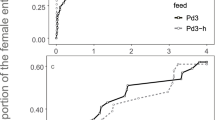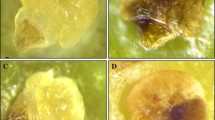Abstract
Empirical studies of spatial heterogeneity in parasitism by insect parasitoids have focused largely on patterns, while the many possible underlying mechanisms have been little studied in the field. We conducted experimental and observational studies on Tachinomyia similis (Diptera: Tachinidae) attacking western tussock moths (Orgyia vetusta; Lepidoptera: Lymantriidae) on lupine bushes at Bodega Bay, Calif., USA. We examined several foraging behaviors that have been hypothesized to create density-dependent variation in parasitism rates, including spatial aggregation of parasitoids to high host density, mutual interference among searching parasitoids and decelerating functional responses of the parasitoid. At the spatial scale of individual bushes, we detected both aggregation to a high density and a decelerating functional response. The resulting spatial pattern of parasitism was best fit by two models; one included an effect of parasitoid aggregation and the other included an effect of aggregation and a decelerating functional response. Most of the variation in parasitism was not correlated with density of O. vetusta.



Similar content being viewed by others
References
Barbour MG, Craig RB, Drysdale FR, Ghiselin MT (1973) Coastal ecology: Bodega Head. University of California Press, Berkeley
Brodman PA, Wilcox CV, Harrison S (1997) Mobile parasitoids may restrict the spatial spread of an insect outbreak. J Anim Ecol 66:65–72
Burnham KP, Anderson DR (1998) Model selection and inference: a practical information-theoretic approach. Springer, Berlin Heidelberg New York
Casas J (1989) Foraging behaviour of a leafminer parasitoid in the field. Ecol Entomol 14:257–265
Chesson PL, Murdoch WW (1986) Aggregation of risk: relationships among host-parasitoid models. Am Nat 127:696–715
Comins HN, Hassell MP (1979) The dynamics of optimally foraging predators and parasitoids. J Anim Ecol 48:335–351
Connor EF, Cargain MJ (1994) Density-related foraging behavior in Closterocerus tricinctus, a parasitoid of the leaf-mining moth, Cameraria hamadryadella. Ecol Entomol 19:327–334
Furniss MM, Knopf JAE (1971) The western tussock moth. (Forest Pest Leaflet no. 120) USDA Forest Service, Portland
Godfray HCJ (1994) Parasitoids: behavioral and evolutionary ecology. Princeton University Press, Princeton
Gross K, Ives AR (1999) Inferring host-parasitoid stability from patterns of parasitism among many patches. Am Nat 154:489–496
Harrison S (1994) Resources and dispersal as factors limiting a population of the tussock moth (Orgyia vetusta), a flightless defoliator. Oecologia 99:27–34
Harrison S (1997) Persistent, localized outbreaks in the western tussock moth Orgyia vetusta: the roles of resource quality, predation and poor dispersal. Ecol Entomol 22:158–166
Harrison S, Maron JL (1995) Impacts of defoliation by tussock moths (Orgyia vetusta) on the growth and reproduction of bush lupine (Lupinus arboreus). Ecol Entomol 20:223–229
Harrison S, Wilcox CV (1995) Evidence that predator satiation may restrict the spatial spread of a tussock moth (Orgyia vetusta) outbreak. Oecologia 101:309–316
Hassell MP (1978) The dynamics of arthropod predator-prey systems. Princeton University Press, Princeton
Hassell MP, May RM (1973) Stability in insect host-parasite models. J Anim Ecol 43:693–726
Hassell MP, May RM, Pacala SW, Chesson PL (1991) The persistence of host-parasitoid associations in patchy environments. I. A general criterion. Am Nat 138:568–583
Hastings A (1997) Population biology, concepts and models. Springer, Berlin Heidelberg New York
Holling CS (1959) Some characteristics of simple types of predation and parasitism. Can Entomol 91:385–398
Hunter AS (2000) Gregariousness and repellent defences in the survival of phytophagous insects. Oikos 91:213–224
Ives AR (1992) Density-dependent and density-independent parasitoid aggregation in host-parasitoid systems. Am Nat 140:912–937
Ives AR, Schooler SS, Jagar VJ, Knuteson SE, Grbic M, Settle WH (1999) Variability and parasitoid foraging efficiency: a case study of pea aphids and Aphidius ervi. Am Nat 154:652–673
Jones TH, Hassell MP, Pacala SW (1993) Spatial heterogeneity and the population dynamics of a host-parasitoid system. J Anim Ecol 62:251–262
Kareiva P, Odell G (1987) Swarms of predator exhibit 'preytaxis' if individual predators use area-restricted search. Am Nat 130:233–270
Maron JL, Harrison S (1997) Spatial pattern formation in an insect host-parasitoid system. Science 278:1619–1621
Maron JL, Harrison S, Greaves M (2001) Origin of an insect outbreak: escape in space or time from natural enemies? Oecologia 126:595–602
McCann K, Hastings A, Harrison S, Wilson W (2000) Population outbreaks in a discrete world. Theor Popul Biol 57:97–108
McCullagh P, Nelder JA (1989) Generalized linear models, 2nd edn. Chapman and Hall, London
Murdoch WW, Briggs CJ (1996) Theory for biological control: recent developments. Ecology 77:2001–2013
O'Neil RJ (1997) Functional response and search strategy of Podisus maculiventris (Heteroptera: Pentatomidae) attacking Colorado potato beetle (Coleoptera: Chrysomelidae). Environ Entomol 26:1183–1190
Pacala SW, Hassell MP (1991) The persistence of host-parasitoid associations in patchy environments. II. Evaluation of field data. Am Nat 138:584–605
Press WH, Teukolsky SA, Vetterling WT, Flannery BP (1994) Numerical recipes in C, 2nd edn. Cambridge University Press, Cambridge
Rosenheim JA, Mangel M (1994) Patch-leaving rules for parasitoids with imperfect host discrimination. Ecol Entomol 19:374–380
Rosenheim JA, Heimpel GE, Mangel M (2000) Egg maturation, egg resorption and the costliness of transient egg limitation in insects. Proc R Soc Lond B Biol Sci 267:1565–1573
Sokal RR, Rohlf FJ (1995) Biometry: the principles and practice of statistics in biological research, 3rd edn. Freeman, New York
Stiling PD (1987) The frequency of density dependence in insect host-parasitoid systems. Ecology 68:844–856
Strong DR, Whipple AV, Child AL, Dennis B (1999) Model selection for a subterranean trophic cascades: root-feeding caterpillars and entomopathogenic nematodes. Ecology 80:2750–2761
Tillman PG (1996) Functional response of Microplitis croceipes and Cardiochiles nigiceps (Hymenoptera: Braconidae) to variation in density of tobacco budworm (Lepidoptera: Noctuidae). Environ Entomol 25:524–528
Turchin P (1987) Population consequences of aggregative movement. J Anim Ecol 58:75–100
Waage J (1983) Aggregation in field parasitoid populations: foraging time allocation in a population of Diadegma (Hymenoptera, Ichneumonidae). Ecol Entomol 8:447–454
Walde SJ, Murdoch WW (1988) Spatial density dependence in parasitoids. Annu Rev Entomol 33:441–466
Wang B, Ferro DN (1998) Functional responses of Trichogramma ostriniae (Hymenoptera: Pyralidae) under laboratory and field conditions. Environ Entomol 27:752–758
Wilson WG, Harrison SP, Hastings A, McCann K (1998) Exploring spatial pattern formation in models of tussock moth populations. J Anim Ecol 69: 94–107
Acknowledgements
We would like to thank P. Chesson, P. de Valpine, A. Hastings, L. Hurd, B. Inouye, J. Rosenheim, and two anonymous reviewers for discussions or comments on the text, M. Greaves, J. Combs, J. Robertson, and the Spatial Group for much needed assistance in the field. This work was sponsored by an NSF grant to S.P. Harrison and an NSF predoctoral fellowship to J. Umbanhowar.
Author information
Authors and Affiliations
Corresponding author
Rights and permissions
About this article
Cite this article
Umbanhowar, J., Maron, J. & Harrison, S. Density-dependent foraging behaviors in a parasitoid lead to density-dependent parasitism of its host. Oecologia 137, 123–130 (2003). https://doi.org/10.1007/s00442-003-1313-5
Received:
Accepted:
Published:
Issue Date:
DOI: https://doi.org/10.1007/s00442-003-1313-5




